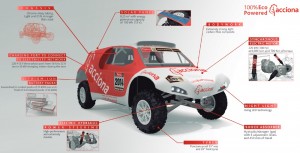
Acciona is the first team to enter a zero emission, fully electric car into the prestigious Dakar Rally. Starting of the 4th January 2015 in Buenos Aires, the electric car driven by Albert Bosch and Agustín Payá will be pushed through 9 000kms across three countries – Argentina, Chile and Bolivia – ending on the 17th of January.
In the 27 year history of the Dakar, the toughest race for man and machine, a 100% electric vehicle has never been registered before. Normally, the average participant uses 2 250lts of fuel and emits 22 000 metric tonnes of carbon – the Acciona vehicle will not need a drop and will emit absolutely nothing.
 Acciona’s 100% EcoPowered passed the technical and administrative checks made by rally organisers.
Acciona’s 100% EcoPowered passed the technical and administrative checks made by rally organisers.
100% EcoPowered took two years of R&D to plan and 20 people to design. The synchronous electric motor, which is 200kW engine – equivalent to a 300hp, weighs only 80kgs as opposed to 280kgs. It has a set of 4 removable lithium-ion battery packs capable of storing 140kWhrs. The new innovation – a quick release sliding battery to allow for possible changes during the race.
Its chassis is constructed from chrome-moly tubing – which is far lighter but much stronger than steel and the bodywork is made of carbon-fibre composite.
In addition, it uses a hundred watts of solar panels to power telemetry and security systems within the vehicle.
The Dakar Rally is definitely not a race to be messed with or laughed at. As many as 60 people (including 27 competitors) have died during the race. There is actually a 2 day stint where competitors do not have access to their service vehicles at all.
Acciona is not untested in the renewable department with this vehicle completing their ‘eco-friendly trifecta’ so to speak. The first was a sled that reached the South Pole powered by a system of kites in 2011 and the second was a yacht that participated in the Vendeé Globe without using any fossil fuels at all in 2012.
Their progress can be monitored here.
Other Specifications Include –
[one_half last=”no”]
Class:
Energy system:
Battery recharging systems using the
electricity network:
Total length:
Height:
Maximum weight:
Average weight:
Minimum weight:
Chassis:
Bodywork:
Motor:
–
Torque:
Batteries:
Solar panel:
Maximum speed:
Energy consumption (kWh):
CO2 emissions in race:
[/one_half][one_half last=”yes”]
T1 – “NRJ-Alternative Energy Challenge”
range of 350km in race conditions
domestic charging port (220V), industrial connection (400V) and fast recharging system (50kW)
5.05m / total width: 2.18m/ Distance between axles: 3.16m
1.90m (variable according to shock absorber compression)
2,550kg (at maximum energy capacity)
2,100kg (at 75% energy capacity)
1,250kg (at 25% energy capacity)
Chrome-moly tubing
Extremely strong, light carbon-fibre composite
Synchronous electric, producing 220kW (300hp) at 6,000rpm
700 Nm
140kW/h lithium-ion batteries in 4 removable packs
High-performance panel producing 100Wh
150km/h, self-limited electronically
from 20 to 45kWh/ 100Km (according to type of terrain)
0 gr.
[/one_half]
Tags: 100% electric vehicle, Acciona’s 100% EcoPowered, First Fully Electric Car Enters Dakar Rally, fossil fuels, lithium-ion battery packs, renewable department, solar panels, zero emission
